#legend of wawel's dragon
Explore tagged Tumblr posts
Text
Polish people when Brother Death said they should put poison in a sheep and feed it to the beast that look weirdly like a dragon:

#blood origin#witcher blood origin#the witcher#legenda o smoku wawelskim#legend of wawel's dragon#szewczyk dratewka#polish reference#polish folklore reference
354 notes
·
View notes
Text
sculptures* round 1 poll 1
*and installations and some other stuff i didn't know where to put
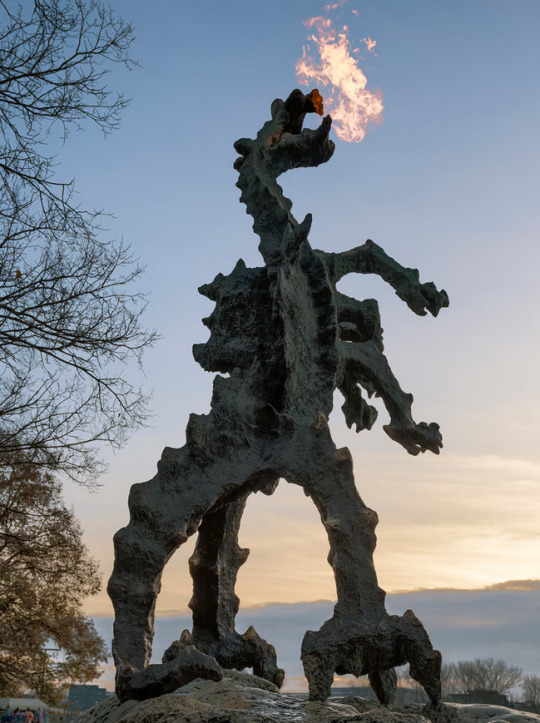
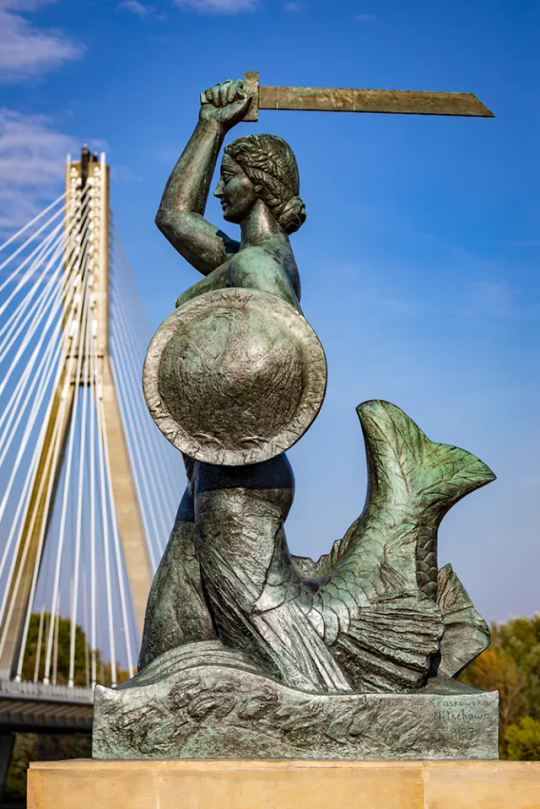
Smok Wawelski (The Wawel Dragon) by Bolesław Chromy, 1969:
propaganda: This is a famous and beloved statue outside of Wawel Castle (pronounced Vavel) in Kraków. The story of Smok Wawelski goes that he'd been eating all the animals (and people?) in Kraków so the king ordered his sons to kill him, but obviously the dragon is very dangerous. The princes tricked him by filling animals with tar and leaving them out. He ate them and when he tried to breathe fire, his insides burned up. There is a second version that says a cobbler tricked him into eating a tar-filled sheep and the tar made him so thirsty he drank the Wisła (the Vistula, the river that runs through Kraków) until he burst.
Fun fact, those are not extra arms but rather extra heads. Also, you can text the dragon to ask him to breathe fire, and then he does. He gets thousands of texts a day.
about the artist: When I was a kid, I was sure this statue was the actual Smok Wawelski that had somehow carbonized over a thousand years, but alas no, a guy made it in 1969 out of bronze. Bronisław Chromy was an artist, a professor, and Dragon Mother. He passed away in 2017.
Pomnik Syreny (Monument of the Warsaw Mermaid) by Ludwika Nitschowa, 1939:
propaganda: The Warsaw Mermaid is the symbol of Warsaw, and her image is all over the city in various forms. She's a warrior and is depicted with a sword and shield. She lives in the Wisła River (the Vistula), which runs thru Warsaw. There are different variants of her legend, but they all have something to do with her involvement in the foundation of Warsaw and her eternal role in protecting the city.
There are several statues of Syrenka around Warsaw, but the one I picked was created by Ludwika Nitschowa in 1936. It is made of gunmetal, and it stands on the bank of the Wisła. The model for this statue was a Polish poetess named Krystyna Krahelska. Krahelska joined the Home Army during WWII and participated in the Warsaw Uprising. She was shot and killed while rescuing a wounded colleague. I think it's really special the way the myth of Syrenka played out like this -- she really did protect the city, like in the legend. Incidentally, this statue was one of the few pieces of art in Warsaw not destroyed by the war.
tldr: badass warrior mermaid, made by a badass woman, modeled on a badass woman. women!
about the artist: Ludwika Nitschowa is the creator several famous statues in Poland, including of Maria Skłodowska-Curie, Copernicus, and several of Fryderyk Chopin.
both statues were submitted by @slaviclore 🐉🧜♀️
#warsaw#warszawa#kraków#cracow#poland#ludwika nitschowa#bolesław chromy#ok nie zawiedźcie mnie... chcę tu zobaczyć porządną ogólnopolską rozróbę#i mean i remember how much yall loved pruszkowski's dragon painting so i fear you might be biased#but. go warsaw!!!#polls#sculptures#br3r1
801 notes
·
View notes
Text

happy year of the dragon 🎉🎊🐉 with our favorite golden dragon
(and, because it wouldn't be a post of mine, after all, without a long footnote: to be clear, villentretenmerth was inspired by the legend of the dragon of wawel hill, and when people (meaning: netflix) erroneously claim that he was inspired by asian dragons instead, and mention nothing of this krakówian dragon nor the cobbler twiney whom defeated it, it actually kind of ticks me off, not only because i find it lazy, but also because the whole point of villentretenmerth's character is that he's a subversion of the type of cruel, greedy dragon from european mythology... however, i'm setting all of this aside momentarily, because since i was born in 2000, my zodiac is that of a golden dragon, and because i also happen to be a witcher fan... i call for borch-posting)
#my two girlfriends. and yes. they smoke weed#the witcher books#art#my art#c: borch three jackdaws#villentretenmerth#c: véa#c: téa#'there's a lot of CoMpLeXiTy To LiMiTs oF tHe PoSsIbLe'#im sorry im like this. but it must be like this. nothing can anymore be changed. by the diamonds at the ends of your eyelashes
33 notes
·
View notes
Text
Slavic Dragon
A Slavic dragon is any dragon in Slavic mythology, including the Russian zmei (or zmey; змей), Ukrainian zmiy (змій), and its counterparts in other Slavic cultures: the Bulgarian zmey (змей), the Slovak drak and šarkan, Czech drak, Polish żmij, the Serbo-Croatian zmaj (змај), the Macedonian zmej (змеј) and the Slovene zmaj. The Romanian zmeu could also be deemed a "Slavic" dragon, but a non-cognate etymology has been proposed.
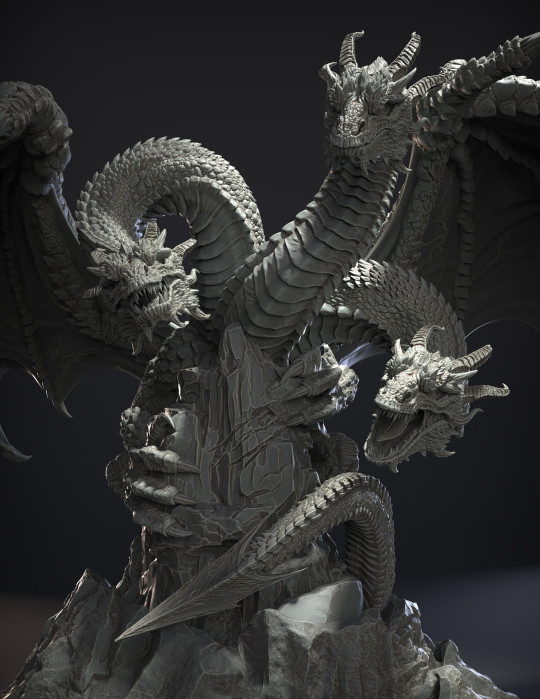
pic by Virinchi Studios
A zmei may be beast-like or human-like, sometimes wooing women, but often plays the role of chief antagonist in Russian literature. In the Balkans, the zmei type is overall regarded as benevolent, as opposed to malevolent dragons known variously as lamia, ala or hala, or aždaja.
The Polish smok (e.g. Wawel Dragon of Kraków) or the Ukrainian or Belarusian smok (смок), tsmok (цмок), can also be included. In some Slavic traditions smok is an ordinary snake which may turn into a dragon with age.
Some of the common motifs concerning Slavic dragons include their identification as masters of weather or water source; that they start life as snakes; and that both the male and female can be romantically involved with humans.
Etymology
The Slavic terms descend from Proto-Slavic *zmьjь. The further derivation that Serbo-Croatian zmaj "dragon" and zemlja "earth" ultimately descend from the same Proto-Slavic root zьm-, from the zero grade of Proto-Indo-European *ǵhdem, was proposed by Croatian linguist Petar Skok. Lithuanian scholarship also points out that the connection of the snake (zmey) with the earthly realm is even more pronounced in folk incantations, since its name would etymologically mean 'earthly (being); that which creeps underground'.
The forms and spellings are Russian: zmei or zmey змей (pl. zmei зме́и); Ukrainian: zmiy змій (pl. zmiyi змії); Bulgarian: zmei змей (pl. zmeiove змейове); Polish zmiy żmij (pl. żmije); Serbo-Croatian zmaj змај (pl. зма̀јеви); Slovene zmaj zmáj or zmàj (pl. zmáji or zmáji).
East Slavic zmei
In the legends of Russia and Ukraine, a particular dragon-like creature, Zmey Gorynych (Russian: Змей Горыныч or Ukrainian: Змій Горинич), has three to twelve heads, and Tugarin Zmeyevich (literally: "Tugarin Dragon-son"), known as zmei-bogatyr or "serpent hero", is a man-like dragon who appears in Russian (or Kievan Rus) heroic literature. The name "Tugarin" may symbolize Turkic or Mongol steppe-peoples.
Chudo-Yudo
The Chudo-Yudo (or Chudo-iudo, чудо-юдо; pl. Chuda-Yuda) is a multi-headed dragon that appears in some wondertale variants, usually considered to be water-dwelling. Some legends portray him as the brother of Koshchey the Deathless, and thus the offspring of the witch Baba Yaga; others present him as a personification of the witch in her foulest form. A Chudo Yudo is one of the guardians of the Water of Life and Death, and his name traditionally was invoked in times of drought. He can apparently assume human-like forms and is able to speak and to ride a horse. He has the ability to regenerate any severed heads.
The term Chudo-Yudo may not be a name for a specific type of dragon at all, but rather a fanciful term for a generic "monster". According to this explanation, the term is to be understood as a poetic form of chudovishche (чудовище) meaning "monster", with a -iudo ending appended simply for the rhyme. Chudo in modern Russian means "a wonder", and once also had the meaning of "a giant"; "yudo" may relate to Iuda, the Russian form of the personal name "Judas", with connotations of uncleanness and the demonic.
Three- and six-headed zmei, slain by the titular hero in "Ivan Popyalov" (Иван Попялов, "Ivan Cinders", Afanasyev's tale #135) appear as six-, nine-, and twelve-headed Chuda-Iuda in the cognate tale #137 "Ivan Bykovich" (Иван Быкович). The inference is that Chudo-Yudo must also be a dragon, even though the word "serpent" (zmei) does not appear explicitly in the latter tale. The six-, nine-, and twelve-headed Chuda-Yuda that appear out of the Black Sea are explicitly described as zmei in yet another cognate tale, #136 "Storm-Bogatyr, Ivan the Cow's Son" (Буря-богатырь Иван коровий сын). The Storm-Bogatyr possesses a magic sword (sword Kladenets), but uses his battle club (or mace) to attack them.
A Chudo-Yudo's heads have a remarkable healing property: even if severed, he can pick them up and re-attach them with a stroke of his fiery finger, according to one of these tales, comparable to the regenerative power of the Lernaean hydra that grows its head back.
Folktales often depict Chuda-yuda as living beyond the River Smorodina (the name may suggest "Stench River")—that is, in the realm of the dead, reached by crossing over the Kalinov Bridge ("White-hot Bridge").
Smok
The terms smok ("dragon") and tsmok ("sucker") can signify a dragon, but also just an ordinary snake. There are Slavic folk tales in which a smok, when it reaches a certain age, grows into a dragon (zmaj, etc.). Similar lore is widespread across Slavic countries, as described below.
Some common themes
Snake into dragons
The folklore that an ancient snake grows into a dragon is fairly widespread in Slavic regions. This is also paralleled by similar lore in China.
In Bulgaria is a similar folk belief that the smok ("Aesculapian snake") begins its life-cycle as a non-venomous snake but later grows into a zmei dragon after living 40 years. Or, if the body of a decapitated snake (zmiya) is joined to an ox or buffalo horn, it grows into a lamia after just 40 days, according to Bulgarian folk tradition published by Racho Slaveykov in the 19th century.
There are also among the East Slavic folk the tradition that a viper transforms into a dragon. In Ukrainian folklore the viper needs 7 years to metamorphosize into a dragon, while in Belarusian folklore the requisite time is 100 years, according to one comparison.
The weather-making dragon, ismeju (or zmeu), of Romanian Scholomance folklore is also locally believed to grow out of a snake which has lived for 9 years (belief found at "Hatzeger Thal" or Hațeg).
Weather
Locally in Ukraine, around Lutsk, the rainbow is called tsmok ("sucker") which is said to be a tube that guzzles water from the sea and rivers and carries the moisture up into the clouds.
There is the notion (thought to be inspired by the tornado) of a Slavic dragon that dips its tail into a river or lake and siphons up the water, ready to cause floods.
In Romanian folklore, dragons are ridden by weather-controlling wizards called the Solomonari. The type of dragon they ride may be the zmeu or the balaur, depending on the source.
The lamia and the hala (explained further below) are also generally perceived as weather dragons or demons.
Balkan Slavic dragons
In Bulgarian lore, the zmei is sometimes described as a scale-covered serpent-like creature with four legs and bat's wings, at other times as half-man, half-snake, with wings and a fish-like tail.
In Bulgaria, this zmei tends to be regarded as a benevolent guardian creature, while the lamya and hala were seen as detrimental towards humans.
Zmei lovers
A favorite topic of folk songs was the male zmey-lover who may marry a woman and carry her to the underworld, or a female zmeitsa (zmeitza) who falls in love with a shepherd. When a zmei falls in love with a woman, she may "pine, languish, become pale, neglect herself.. and generally act strangely", and the victim stricken with the condition could only be cured by bathing in infusions of certain herbs, according to superstition.
In Serbia, there is the example of the epic song Carica Milica i zmaj od Jastrepca (Serbian: Царица Милица и змај од Јастрепца) and its folktale version translated as "The Tsarina Militza and the Zmay of Yastrebatz".
Zmey of Macedonian fairy tales
In most Macedonian tales and folk songs they are described as extremely intelligent, having hypnotizing eyes. However, sometimes Zmey's could be men who would astrally project into the sky when there is a storm to battle the Lamia, a female evil version that wants to destroy the wheat. They were also known as guardians of the territory, and would even protect the people in it. Hostile behaviour was shown if another zmey comes into his territory. They could change their appearance in the form of a smoke, strong spark, fire bird, snake, cloud but almost afterwards he would gain the form of a handsome man and enter the chambers of a young maiden. They fell in love with women who were conceived on the same night as them, or born in the same day as them. He usually guards the girl from a small age and his love lasts forever. Some girls get sick by loving a zmey, and symptoms include paleness, shyness, antisocial behaviour, watery eyes, quietness and hallucinations. They didn't live a long life, because it resulted in suicide. Zmeys would kidnap girls and lead them into their mountain caves where she would serve him.
Benevolent zmei of the Balkans
There is a pan-Balkan notion that the zmei (known by various cognates) is a sort of "guardian-spirit dragon" against the "evil" types of dragon, given below. One explanation is that the Balkan zmej symbolized the patriotic dragon fighting the Turkish dragon, a way to vent the local population's frustration at not being able to overthrow the long-time Turkish rule.
Zmaj of Serbian fairy tales
The zmaj dragon in Serbian fairy tales nevertheless have sinister roles in a number of instances. In the well-known tale "A Pavilion Neither in the Sky nor on the Earth" the youngest prince succeeds in killing the dragon (zmaj) that guards the three princesses held captive.
Vuk Karadžić's collection of folktales have other examples. In "The Golden Apple-tree and the Nine Peahens", the dragon carries away the peahen maiden who is the hero's lover. In "Baš Čelik" the hero must contend with a dragon-king.
Lamia
The lamia or lamya (Bulgarian: ламя), derived from the Greek lamia, is also seen as a dragon-like creature in Bulgarian ethnic population, currently inhabiting Bulgaria, with equivalents in Macedonia (lamja, lamna; ламја), and South-East Serbian areas (lamnia ламња).
The Bulgarian lamia is described as reptile- or lizard-like and covered with scales, with 3–9 heads which are like dog's heads with sharp teeth. It may also have sharp claws, webbed wings, and the scales may be yellow color.
The Bulgarian lamia dwells in the bottoms of the seas and lakes, or sometimes mountainous caverns, or tree holes and can stop the supply of water to the human population, demanding sacrificial offerings to undo its deed. The lamia, bringer of drought, was considered the adversary of St. Ilya (Elijah) or a benevolent zmei.
In the Bulgarian version of Saint George and the Dragon, the dragon was a lamia. Bulgarian legends tell of how a hero (actually a double of St. George, denoted as "George of the Flowers", Cveten Gǝorgi, Bulgarian: цветен Гьорги) cuts off the heads of the three- or multi-headed Lamia, and when the hero accomplishes its destruction and sever all its heads, "rivers of fertility" are said to flow. This song about St. George's fight with the lamia occurs in ritual spiritual verse supposed to be sung around St. George's day.
One of the versions collected by ethnologist Dimitar Marinov [bg] begins: "Тръгнал ми е цветен Гьорги/Да обиди нивен сънор/На път среща сура ламя.. (George of the Flowers fared out / Going around his congregation /On the road he met the fallow lamia..)". Another version collected by Marinov substitutes "Yuda-Samodiva" in the place of the lamia. Three rivers gush out of the dragons head-stumps: typically one of corn, one of red wine, and one of milk and honey. These benefitted the crop-growers, vineyard growers (winemakers), and the beekeepers and shepherds, respectively. .
Other evil Balkan dragons
There is some overlap or conflation of the lamia and the hala (or halla), although the latter is usually conceived of as a "whirlwind". Or it might be described as regional differences. The lamia in Eastern Bulgaria is the adversary of the benevolent zmei, and the hala or ala takes its place in Western Bulgaria.
This motif of hero against the evil dragon (lamia, ala/hala, or aždaja) is found more generally throughout the Balkan Slavic region. Sometimes this hero is a saint (usually St. George). And after the hero severs all its (three) heads, "three rivers of wheat, milk, and wine" flow out of the stumps.
Hala
The demon or creature known as hala (or ala), whose name derived from the Greek word for "hail" took the appearance of a dense mist or fog, or a black cloud. Hala was believed to be the cause of strong winds and whirlwind in Eastern Bulgaria, whereas the lamya was blamed as the perpetrator in Southwestern Bulgarian lore. In Western Bulgarian tradition, the halla itself was regarded as the whirlwind, which guarded clouds and contained the rain, but was also regarded as a type of dragon, alongside the folklore that the smok (roughly equated with "grass snake" but actually the Aesculapian snake) was a crag-dwelling whirlwind.
These hala were also known in East and Central Serbia. Similar lore occur in Croatia, Bosnia and Herzegovina, Montenegro.
Aždaja
The demon hala was also called by other names regionally, in some parts of Bulgaria they were known as aždarha (Bulgarian: аждарха) or ažder (аждер), in Macedonian as aždaja or ažder (аждаја, аждер), in Bosnian and Serbian as aždaja (аждаја).
The word aždaja or aždaha is borrowed from Persian azdahā (اژدها), and has its origins in the Indo-Iranian mythology surrounding the dragon azidahā. As an example, in some local Serbian icons, St. George is represented as slaying the aždaja and not a zmaj.
Pozoj
A pozoj is a dragon of legends in Croatia. In Međimurje County, the Čakovec pozoj was said to dwell beneath the city, with its head under the church and tail under the town square, or vice versa, and it could only be gotten rid of by a grabancijaš (a "wandering scholar", glossed as a "black [magic] student").
The pozoj is also known in Slovenia, and according to legend there is one living underneath Zagreb, causing an earthquake whenever it shrugs. Poet Matija Valjavec (1866) has published some tales concerning the pozoj in the Slovenski glasnik magazine, which also connected the creature to the črne škole dijak ("black school student"), which other Slovene sources call črnošolec ("sorcerer's apprentice"), and which some equate with a grabancijaš dijak
Dragons in Slovenia are generally negative in nature, and usually appear in relation with St. George. The Slovene god-hero Kresnik is known as a dragonslayer.
Representations
There are natural and man-made structures that have dragon lore attached to them. There are also representations in sculpture and painting. In iconography, Saint George and the Dragon is prominent in Slavic areas. The dragon is a common motif in heraldry, and the coat of arms of a number of cities or families depict dragons.
The Dragon Bridge (Slovene: Zmajski most) in Ljubljana, Slovenia depicts dragons associated with the city or said to be the city's guardians, and the city's coat of arms features a dragon (representing the one slain by Kresnik).
The coat of arms of Moscow also depicts a St George (symbolizing Christianity) killing the Dragon (symbolizing the Golden Horde).
Some prehistoric structures, notably the Serpent's Wall near Kyiv, have been associated with dragons as symbols of foreign peoples.
8 notes
·
View notes
Photo
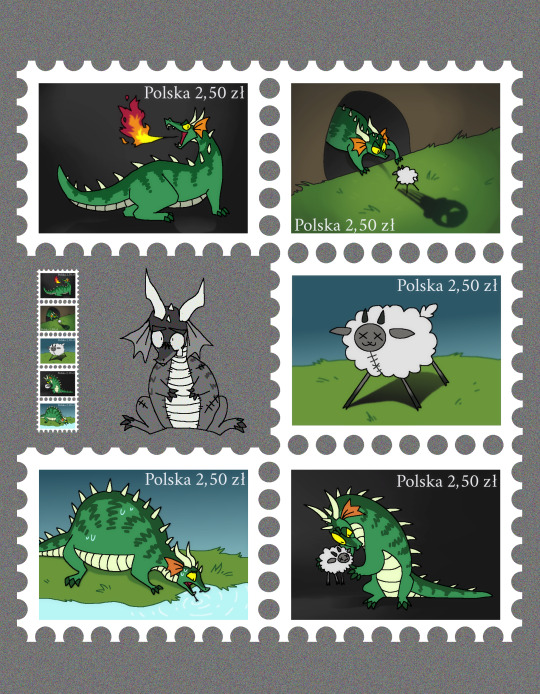
[ID: a chart presenting five stamps with pictures depicting the Wawel Dragon legend. the first stamp shows the dragon in its cave, confidently breathing fire. it is green with darker stripe going from its nose to the tip of its tail. it has a snake shaped head with two upward horns, and spikes on its forehead, back and tail.
in the second stamp the dragon is curiously poking at the sheep standing in front of its cave. the shadow under the sheep has a skull shape. the third stamp shows the sheep. it has X marks instead of eyes and it has a visible sewing mark on its chest.
the fourth stamps portrays the dragon in its cave, taking a closer look at the sheep. it is holding it close it its face, with one eye squinted. in the fifth stamp, the dragon is drinking water from the lake. its body is swollen, as if had already drunk a lot of water.
the stamps are put together in a flipped letter C pattern. in the space between the first and last stamp is a doodle of the Wawel Dragon sitting with a hurt expression, with its body patched up. on its left is a strip of all the stamps in their real-life size. the close the space between the first and last stamp, giving an impression of a prison bar. End ID]
an assignment from my first semester of college, we had to make stamps featuring a polish legend of our choice. of course i choose the Wawel Dragon (Smok Wawelski) because i wanted to draw a dragon.
the legend says that long time ago the city of Cracow was plagued by a dragon. it would eat all of the citizens’ sheep and cattle. many knights have tried killing the beast, but they never succeeded and would instead get eaten by it. but one day a simple shoemaker left a sheep skin filled with sulfur for the dragon to eat. and it did eat it, thinking it was real a real animal. the sulfur burned its throat, so the dragon kept drinking water until it drank so much it exploded.
and yeah the shoemaker was generously rewarded but its not about him lol
#stamps#smok wawelski#polish legend#poland#dragon#/#my art#2021#19/01/2021#//#i was really satisfied with this when i made this but now almost two years later i see some stuff that i would change#buuut i passed the class so whatever#i still think its hilarious how i decided to put this dragon in graphic design prison#also i hope i did fine with the id i kinda struggled with it#if anybody got any suggestion on how i could improve it lmk
45 notes
·
View notes
Photo


Hello again.
Today I'm posting a dinosaur again. Here is Smok (In Polish it means dragon). One of the few dinosaurs discovered in Poland. In Polish, it is called Smok Wawelski (the Wawel Dragon), the name comes from a Polish legend about a dragon inhabiting Krakow. The entire dinosaur was 5–6 m long.
It is very puzzling that its original name is Smok Wawelski, and in English (in books/wiki) simply Smok. So if they don't really translate it, why do they change it at all? I spoke to a friend about it and after about 20 minutes, we still didn't come up with any explanation for this phenomenon.
10 notes
·
View notes
Text

Long ago in the city of Krakow, there was a terrifying creature known as the Wawel Dragon. This dragon would live in a cave on Wawel Hill and terrorize the local villagers. Its fiery breath would destroy crops, its enormous wings would create strong winds, and its mighty roar would send fear into the hearts of all who heard it. The people of Krakow were desperate for a solution to rid themselves of the dragon's menace. They offered a reward to anyone who could defeat the creature and bring peace to their city. Many brave knights tried and failed, losing their lives in the process. One day, a clever young cobbler named Krakus came up with a plan to defeat the dragon. He filled a lamb's skin with sulfur and set it outside the dragon's cave. The dragon, enticed by the smell of the lamb, devoured it whole. The sulfur inside caused the dragon to become incredibly thirsty. As the dragon rushed down to the Vistula River to drink, Krakus was waiting for it. He had prepared a sheepskin filled with tar and sulfur and thrown it into the dragon's path. The dragon, unable to quench its thirst, drank from the river and its belly swelled, causing it to become even more sluggish. Seizing the opportunity, Krakus approached the dragon and thrust a spear into its belly, killing it instantly. The people of Krakow rejoiced, grateful to Krakus for his bravery and cunning. Krakus became a hero and was later named the first ruler of Krakow.
To this day, the story of the Wawel Dragon is celebrated in Krakow. A statue of the dragon stands near the entrance to its cave on Wawel Hill, and the dragon's breath is reenacted with fire periodically, delighting visitors and reminding them of the legend that has been passed down through generations.
The tale of the Wawel Dragon is a beloved part of Polish folklore, highlighting the triumph of courage and wit over adversity. It is a reminder that even the most fearsome of creatures can be overcome with determination and resourcefulness.
While the story of the Wawel Dragon is a popular folklore tale in Poland, it is important to note that folklore often draws inspiration from real-life events or elements of local history. However, it's challenging to pinpoint a specific real-life inspiration for the Wawel Dragon story.

In some interpretations, the Wawel Dragon has been associated with historical events such as volcanic activity or natural disasters that could have led to stories of a destructive creature. Others suggest that the dragon may have symbolized the pagan beliefs and customs that clashed with the spread of Christianity in Poland.
It is also worth mentioning that dragons are a common motif in folklore and mythology worldwide, often representing powerful and mythical creatures that personify various aspects of nature, including chaos, destruction, and rebirth.
While the exact origins and inspirations for the Wawel Dragon story may remain uncertain, it continues to be a cherished part of Polish culture and a reminder of the power of storytelling in shaping collective imagination and identity.

If there is anything you'd like to learn please let me know
#the Wawel Dragon#folklore#witchdoctorintraining#dragon#storytelling#Polish Folklore#slavic folklore#krakow#Vistula River#Krakus#poland
4 notes
·
View notes
Note
Have you heard about Legendy Polskie by Allegro? It's a (unfortunately unfinished) series of short movies and music videos based on various Polish legends (f.e. about Pan Twardowski and Wawel Dragon) and I think that you may like it. You may watch it here: https://youtube.com/playlist?list=PLe16rrCd1gLZHvq2ZnRqkwnWW7qcqOKCe&si=9wT9rKpjMlWAiySb
Hi, and thanks for the PM.
No, never heard of this series before. Will take a look at it, when the Christmas calendars I'm watching this year are over. Thanks for the tip.
1 note
·
View note
Text
Monday, 8th of March 2021, A conversation with the legend himself.
We live in a [world] apparently bent on inculcating a national will to amnesia, to excise certain pasts, particularly when a great wrong has occurred. (32) One has to relinquish control to get it back again. Let us try from [another angle], free of any metaphysics of [immediacy] and without humanistic nostalgia. (2)
Rendez-vous at the dragon’s den.
JM: Sorry to intrude like this. I understand my visit isn’t welcome, but I just have this itching urge to ask you. How did you become the dragon of Wawel Hill?
SW: Ugh, not you humans again. Using my demise to empower yourselves. All of these myths they created about me, they’re just storytelling.
JM: So tell me — what REALLY happened? I promise I won’t judge.
SW: Hm. Okay. Well, I was once a prince. But of course I made a shitty deal with a powerful man, who turned me into a dragon. People thought I was doomed, but honestly being a dragon wasn’t so awful. Except of course having to find food for myself. Humans are so greedy, they take everything for themselves and then set their own values on them. There’s practically no room for others. Anyways, in order to fulfill myself, I started going for the livestock. I never had a taste for human flesh, like all these stories paint me out to be. Humans eat their own livestock too! But as soon as I do it.. well. They started accusing me for snatching their children. All this bullshit man..
JM: And I assume that’s why they poisoned you?
SW: They didn’t just poison me. They blew me up into the air! I mean, isn’t that crazy? I exploded like a firework. It just blows my mind. Literally.
JM: Ouch.
SW: Yeah. You don’t say. And to have the audacity to turn It into a lecture. The tragic story of Smok Wawelski should serve as a warning to not be overly confidence and greedy. Seriously, who is greedy here?! Bla. Bla. Bla.
JM: I’m so sorry about that. One day they’ll understand. I’m just trying to find a way how..
SW: Maybe the first step is to NOT show up as a beast. Trust me, it won’t end well for you.
It is renegotiated, challenged, or even destroyed prior to emerging anew, through transformation of the mechanisms geared towards profit and justice alike, and continuous metamorphosis in the need for justification under fire from critique. (35)
0 notes
Text
Week 3 Prompt
#1 The Urban Legend of Krakow's dragon, the Wawel Dragon. This legend comes from the time of King Krak's reign in Krakow, Poland. It is said that there was a dragon living in a cave right near the castle. The king wanted the dragon to be slain because the dragon got more comfortable with each day. The King made an announcement and said whoever kills the dragon will be crowned King and be married off to his daughters. Many kings, knights, princes, and others attempted to kill the dragon but would all fail and fall victim to the dragon. One day a boy showed up on the front steps of the castle and came to the king with nothing, he had no weapons and no armor. The king decided to give the boy a chance. The boy asked the King for sheep wool and sulfur, and with this, he made a fake sheep. He left it out in front of the dragon's cave and the dragon ate it. The sulfur started burning the dragon from the inside and eventually, the dragon exploded. The boy, who was a shoemaker, got to marry princess Wanda for his heroic moment.
#2 The Legend of La Llorona. The legend is based on a weeping woman who drowned her kids. This legend is popular among Spanish families. It is told for kids to not go out at night and go near bodies of water. Supposedly the ghost of this woman appears near bodies of water in the middle of the night and attracts kids with her cries over her dead children. The ghost drowns kids who come near her the same way she drowned her own children. She drowned her kids because they kids were considered illegitimate children and the father of the kids left her for another woman. She drowns her sons to prevent her kids from being raised by the woman the father would marry.
1 note
·
View note
Photo





Kraków Bulwar Wołyński „Smoki”, kwiecień 2014 autorzy: Konrad 'Mehes' Kowal i Piotr 'Tuse' Jaworski foto z 21 października 2017
><><><><><><><><><><><><><><><
Kraków, Poland Wołyński Boulevard "Dragons", made in April 2014 by Konrad 'Mehes' Kowal i Piotr 'Tuse' Jaworski taken on 21 October 2017
Kraków is called The Dragon City for a reason.
Disclaimer: I am not the author of the art itself; I own only the photos.
#street art#urban art#Europe#Poland#Polska#Kraków#Krakow#Cracow#murals#graffiti#dragons#legends#Smok Wawelski#Dragon of Wawel#photographers on tumblr#original photography
26 notes
·
View notes
Text
Witcher is not Slavic! It’s Polish. But in a good way.
Warning: It’s long post. And I didn’t even covered all I wanted. Also I’m not really used to write in English so sorry for mistakes. I tried to find links to as many English translations to things I mention as I could.
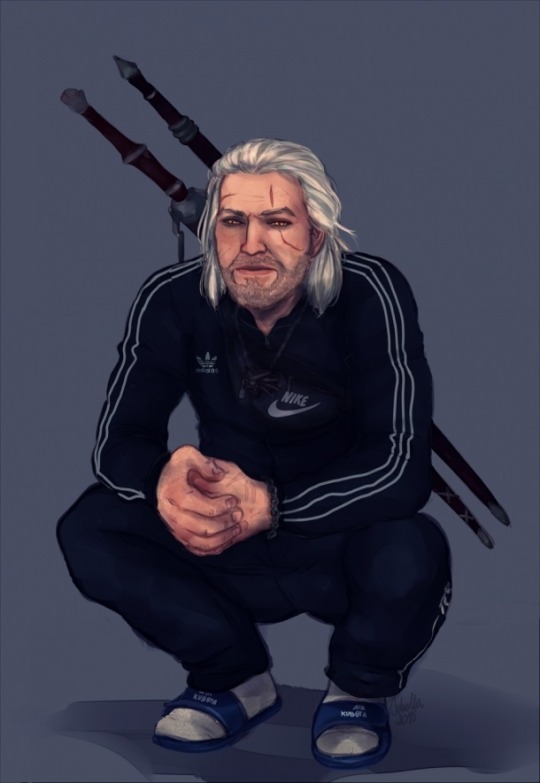
That’s the one. True Pole.
There is a lot talking about how slavic The Witcher is. Monsters, believes ect… But it’s not. The Witcher was written by Andrzej Sapkowski, who was a fan of fantasy and he wrote fantasy. Based on what he knew from the genre. But also it was written by Polish author, in Polish language, for Polish readers and to be published in Poland. We can say many things about Sapkowski, but one thing is certain, he is great writer. It’s really easy to forget and I’m kinda suprised everytime I read the books. So our Wiedźmin was a fantasy stories, then saga, wtitten by fantasy fan that did’t pretend that he wasn’t from Poland.
So you get referances to King Arthur’s legends (like it’s main inspiration later in books), you get classical fairy tales like Little Mermaid (Bit of Sacrifice - my favourite story) or Snow White (Renfri). In Time of Contempt (Czas Pogardy) when Ciri first meets the Wild Hunt (and yes, wild hunt appears somewhere in Slavic mythology but mostly it’s conected to German, Norse and Celtic ones) it’s basicly re-telling of The Erl-King by Goethe.
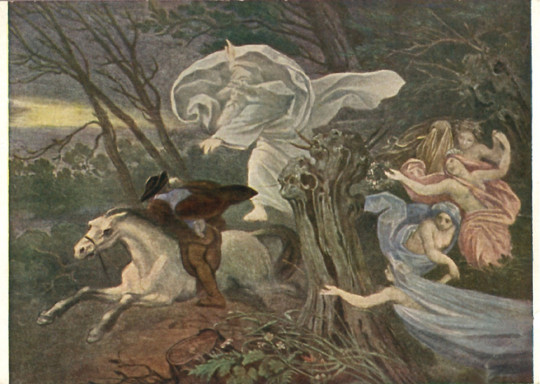
The Erl-King
But there are also other inspirations. In the story with golden dragon the villagers tried to kill the first dragon (that just had baby dragon) by giving her sheep stuffed with sulfur, tar and belladona. Then they also suggest to give it to the golden one. Sounds ridiculus, right? Well, if you were born in Poland you know from very young age that giving dragon a sheep stuffed with sulfur is a best way to kill one! That’s how Szewczyk Dratewka killed the dragon that live under the Wawel castle in Kraków.
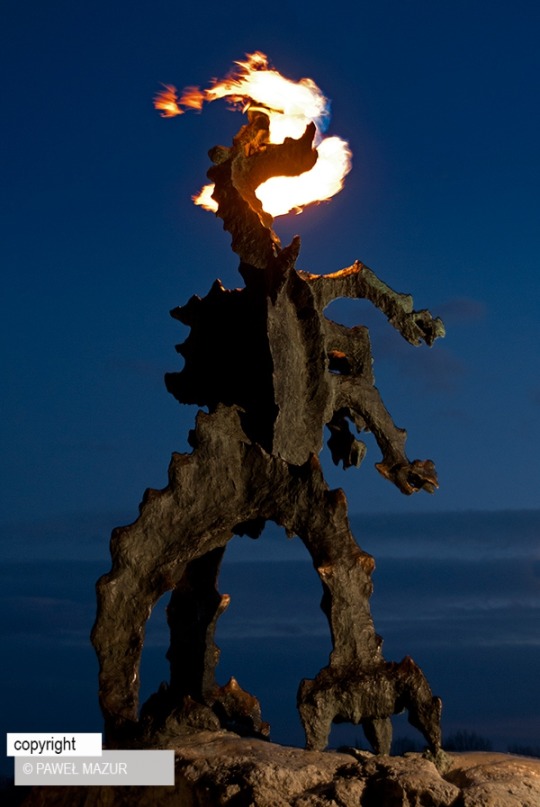
That’s the statue of said dragon under Wawel castle. Yes, it really breaths fire.
Also Duny, the hedgehog in knight’s armor may seems a little odd. But most children in Poland will find it completly normal and on top of that they will know that love can break the curse. The idea is based on a poem from one of the most popular poets that wrote for children (not only) – Jan Brzechwa. It’s called Baśń o Stalowym Jeżu – The Tale of Steel Hedgehog and it’s really beautiful, sadly i did’t find any English translation.
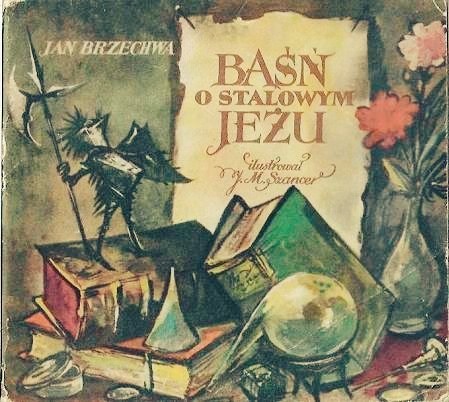
I remember as my mom read me this when I was little.
You have to understand that we don’t really learn at schools about Slavic mythology. According to books before baptism there were Pagans, they had some believes and then history of Poland starts with Christianity. It’s bullshit but yeah. So even about Dziady (Forefather’s Eve) we learn as we read Mickiewicz’s book of the same title. Or we hear some local stories. I always knew a lot about witches’ sabbaths on Łysa Góra (Bald Mountain – it was also quest in Witcher 3) because it’s my region.
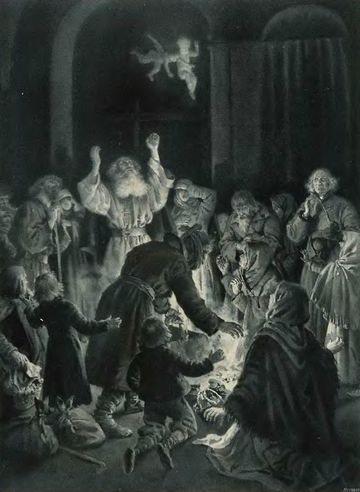
Second part of Dziady by Adam Mickiewicz, the one that covers Forefather’s Eve ritual is actually one of the few books everyone reads at school.
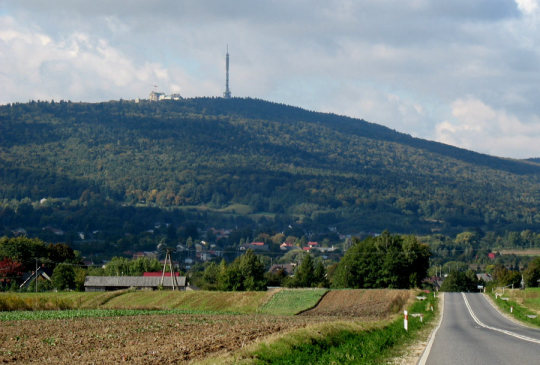
And that’s Łysa Góra. Most known place of witches sabbaths. And actual place of Pagan cult. Part of my home region.
Sapkowski took inspirations from what he knew. Nothing more and nothing less. And thanks to that, as we were raised in the same culture we also know it and recognize it. But the thing i most enjoy is the climate of the books. Because I read these books and it’s clear that it’s now based in Poland and characters are not Polish. But wen I read it you can feel that it’s… homey. These are little bits that sadly were lost in translations.
In Kraniec Świata – story with Torque the Silvan and elves, when Geralt is looking for a job and he’s talking to villagers, when i read this I KNOW that the author is from Poland. In the first village when they talk about everything bad that is happening in their village and how it must be made by monsters, and also about old Nachakowa (Old Nan the Hag) and some officials and some neighbourly quarrels - I was like „Yeah, guys, I feel ya. I work with clients too”. But what was lost in translation were Nietopyrze. In Ensligh translations it was translated as „bats” and it’s kinda correct. But the proper word for “bats” in Polish is “nietoperze”. “Nietopyrze” is a form that is associated with people from small villages that lacks an education. And even Geralt is kinda making fun of that. Then when they’re talking about Silvan they say „diaboł” insted of „diabeł” (meaning devil and it’s same situation as before). Here even Jaskier corrects them by saying „Diabłów nie ma” („There are no devils”) and the Duhn insists that it’s „diaboł”. And of course there old lady that everyone reffers to as „grandma”. We still have that. Even in cities.
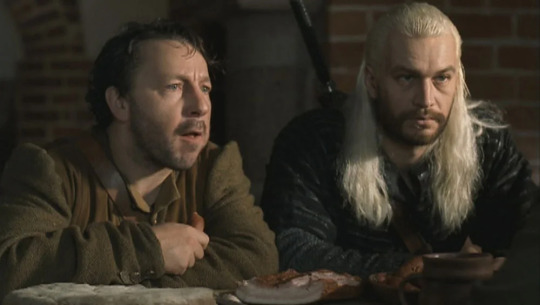
The faces of people that have to talk to people at work. That’s Jaskier and Geralt from Polish tv series btw.
Btw when i read about these villages I thing about my grand-grandmother’s house that I visited when I was a child. There were no shop in the village, and even no church. The church was in the village near by. But we had farmlands there – I remember picking up potatoes, we had chickens that we used to get eggs (they were also used for soups but luckily I never saw that). And there were no toilet in the house, no gas – there were tiled stove. But we had a horse! These are my memories, welcome to Poland.
But as we talk about people, it’s time to explain why I added that The Witcher is Polish but in a „good way”. Sometimes when I see comments on the internet there are just ones about how every character should be white and straight because it’s Polish book and of course in Poland everyone is white and straight. Exept it’s not the case and never was. And The Witcher was written by male fantasy author in 90s. And it’s leftish as hell.
The Continent is not Poland, it’s very clear. The characters have names from all over the world which also suggest that THEY ARE NOT POLISH. And there are evles. We never had elves in Poland. Rusałki yes, but not elves. And the whole series is a manifest on how discrimination based of someone’s nacionality, race, looks, proffesion etc. is leading to death and destruction. It’s also about what happens if we destroy nature. And women are the ones in charge. Socceres are using kings as their puppets. The patriatchy is criticized (Calanthe). Femine forms? Hell yeah! Ciri is a Wiedźminka (female form from the Witcher) not Wiedźmin. She’s a girl alfter all. And she can bothe learn to fight and how to kill monsters and wear makeup because she feels like it and she won’t practice because she doesn’t feel good when she’s on her period. Yes, Sapkowski in 90s decided that it’s important to mention that a teenage girl have period. And he made fun of how men don’t think about it and how uncomfortable they get when someone mentions is. This scene with Triss were much more important in books then in Netflix series where she just mentions it.
But as we talk about women – Yeneffer is helping with unwanted pragnancies (of course for money but don’t expect her to do anything for free) and Geralt calls women’s right to choose sacred. Yes, our beloved White Wolf is pro choice. Also sorceresses are cononicly bisexual. And faith fanatics are bad guys while most (if not all) good characters are atheists. That’s also how our country works till this day.
So yes, Witcher is Polish but in a way that we fight for justice, freedom, for equal rights. If you want to write stories based on The Witcher it don’t have to be Slavic. You can use Andersen’s or Brothers Grimms’ fairy tales. You can use stories you heard as a child. Other mythologies. Even other fantasy works. Because it’s what Sapkowski did. He took what he knew and he happend to know what was known in Poland. And of course you CAN use Slavic myths. But you can also read some legends as the one about Wawel’s dragon. Or about knights sleeping under Giewont mountain. Or some poems – Mickiewicz or Leśmian for example. I love Leśmian. Maybe I will write a post about these Polish legends and poems that would add to the lore. What do you think?
Slavic mythology IS NOT A CANON. But feminism, ecologism, equality IS A CANON. Remember about that.
#the witcher netflix#the witcher#geralt#geralt of rivia#jaskier#julian alfred pankratz#witcher#poland#witcher meta#yennefer of vengerberg#ciri#cirilla fiona elen riannon#wiedzmin#hexer#polish culture
870 notes
·
View notes
Text
Smok Wawelski (Archosaur)
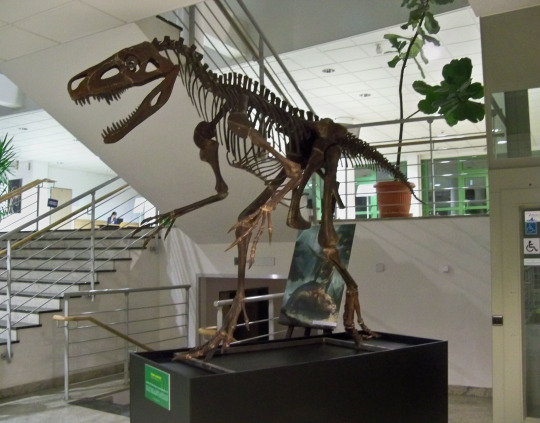
This guy right here is called “Smok Wawelski”, named after a dragon in a popular polish legend (the name translates to “Dragon of Wawel”). It lived during Late Trassic on the territory of, what is now, Poland (more specifically a village called Lisowice). He’s estimated to be around 5 or 6 meters (aka 16 or 20 feet) in length, its skull is 50-60 centemeters long (20-24 inches).
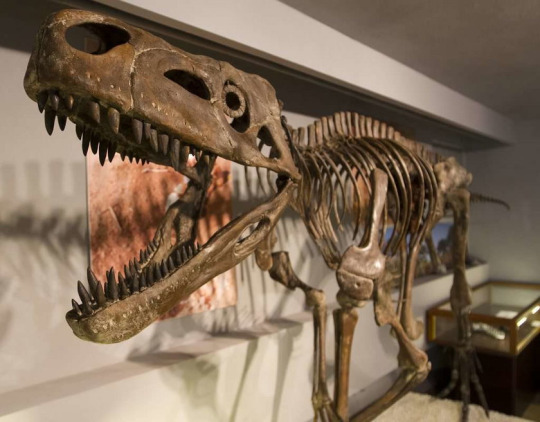
Smok lived alongside a synapsid called Lisowicia (named after the village). It was most likely hunted down pretty frequently by Smok. Here’s a picture of it below.
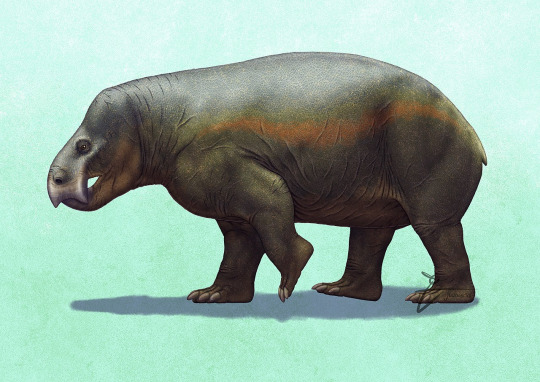
What’s interesting about Smok is that nobody really knows what type of archosaur it is. It could be a rauisuchid, prestosuchid, an ornithosuchid pseudosuchian or a theropod dinosaur. Here are some reconstructions.
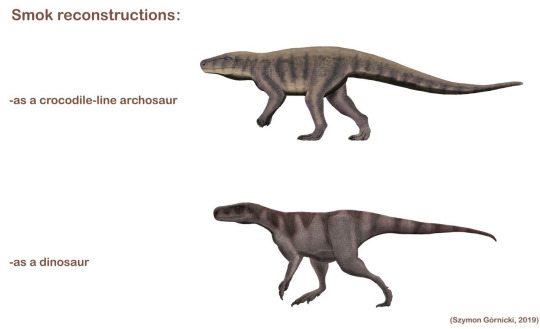
Smok’s one of my favorite prehistoric creatures so I figured I’d make a post about it :) I still don’t really understand how to use tumblr properly but this seems fun.
100 notes
·
View notes
Text

@ckret2 He's a main character of a Polish book series by Stanisław Pagaczewski and an animated series, adapting the first of them, by the name of "The Abduction of Baltazar Gąbka(*Sponge)". The Dragon of Wawel is a well known Polish legend in which a Dragon residing under a castle in Kraków is killed with poison by a smart shoemaker. In the books Mr Wawelski Dragon instead of dying gets ill and turns friendly. He becomes the best friend of the Prince Krak as well as inventor and adventurer.
In the events of the first book, he and a brave Polish-Italian chief (Bartolini Bartłomiej, herb Green Garsley mamma mia!) are send to rescue the Profesor Baltazar Gąbka, who traveled to the Rain Country to study flying frogs and got abducted by the Great Rainer (their dictator), so that he would breed gigantic flying frogs for military purposes.
While traveling there they have many adventures in funny and absurd countries and eventually help overthrowing the dictator. The book is more nuanced about it; the other Rainers are depicted as just normal (green) people, and organize a revolutionary movement to overthrow the dictatorship, which the Dragon and Bartolini only help. In the animated series the Rain country is sorta more like "Evil Imperium"
As an act of patriotism, as well as rebelion against the americanization of tumblr and fandom spaces, I'm going to now start a bit where I talk about obscure characters from my childhood media the way everybody's talking about their cartoon blorbos.
29 notes
·
View notes
Text
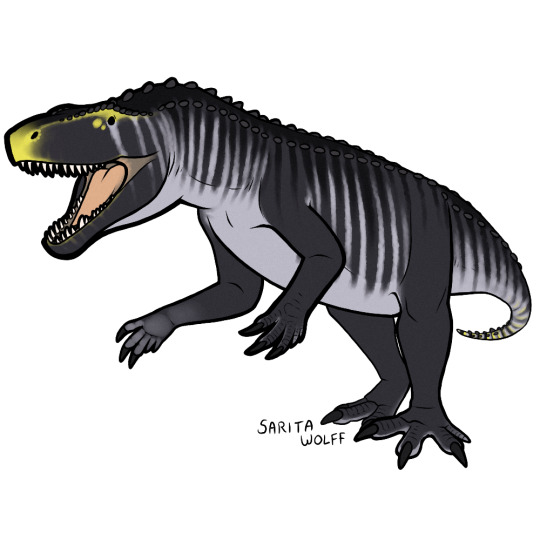

#Archovember Day 21 - Smok wawelski
Named after the Wawel Dragon of Polish legend, the enigmatic Smok wawelski is in fact so enigmatic that the mythical beast is still what pops up first when you google it. I had been avoiding including Smok in Archovember for the past three years simply because we Just Don’t Know what it is. And it’s a little hard to draw something when all paleontologists know about it is “well, it’s an archosaur? And it’s uh… big?”
Living in Late Triassic Poland, Smok wawelski was larger than any known Triassic or early Jurassic predatory archosaur. Estimated at 5 to 6 metres (16 to 20 ft) in length, it was certainly the apex predator of Europe. Examination of Smok coprolites (fossilized poop) indicate that it was able to crush and swallow bone… including it’s own teeth which had likely broken during feeding! It was a generalized predator, feeding on a variety of fish, temnospondyls, and dicynodonts, and was able to extract the salt and marrow from these animals’ bones. Other than that, it has not been thoroughly studied. It could be some kind of pseudosuchian, or it could be an early theropod dinosaur. We Just Don’t Know. But it sure must have been a formidable dragon either way.
Smok would have lived alongside the neotheropod dinosaur Liliensternus, the rauisuchids Polonosuchus and Teratosaurus, a silesaurid, temnospondyls, and the elephant-sized dicynodont Lisowicia.
39 notes
·
View notes